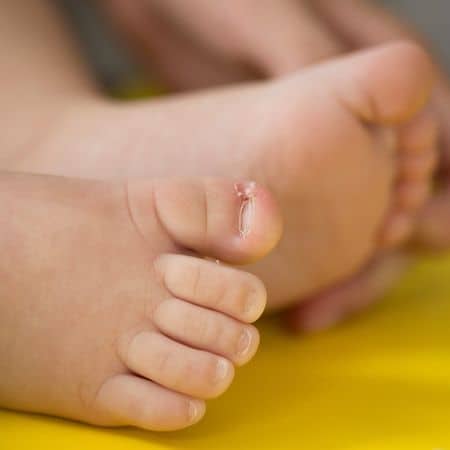Ingrown nails most commonly occur during teenage years or when we get older and nail changes start to occur. Most people do not associate ingrown toenails with young children or babies, but it can happen! Let’s run through ingrown toenails in infants and children.

Why do ingrown nails in infants and children happen?
The causes of ingrown nails in younger children are mostly similar to common causes in adults, but there are a few differences:

Nail cutting
Younger children and infants rely on their caregivers to cut their nails. The process of cutting someone else’s nails is often more difficult (especially on a wriggly child!) and you are more prone to making mistakes. This can lead to ingrown nails caused by very short nails or spikes of nail left behind.
Foot size changes
One of the most common causes of ingrown nails (in any age range) is pressure from footwear on the nail. This commonly happens when the shoes are too short for the feet and the longest toe is repeatedly pressed into by the shoe. This means the flesh surrounding the nail (sulcus) gets slowly pushed into the nail, until eventually the nail pierces the skin and an ingrown nail occurs.
If you have kids, you will know that their feet can grow at a rate hard to believe! Often kids can change shoe size in a matter of months. Unless you are actively checking the length for them, children also may not complain about tight shoes until they become quite painful. In combination, this can lead to a much higher risk of ingrown nails in young kids.
Crawling/onesies
While babies may not walk or wear shoes, they can still be affected by pressure on their nails. There are two main causes of ingrown nails in babies. Firstly, they wear onesies which pull tightly on their feet. Secondly, when they begin to crawl and drag their nails on the floor. Not every baby will be affected. It seems to be more likely when there is a family history of ingrown nails. Some unlucky babies can develop ingrown nails for no identifiable reason too. Luckily, most babies will grow out of this phase quite quickly.
How do we treat ingrown toenails in infants and children?
In young children and especially infants, podiatrists will usually rely on conservative treatment for ingrown nails. Sometimes a course of antibiotics may be needed to resolve an infection. Though most children heal very quickly on their own once the physical cause has been addressed.
The causes for ingrown nails in this younger population can often be quickly addressed (e.g. buying bigger shoes) to prevent reoccurrence, and should not need more invasive treatment like nail surgery. In the rare case that the ingrown nail does not respond to conservative treatment, referral to a paediatrician for advice would usually be done.

If you are worried about your child’s nails
The person to see for any ingrown toenails in infants or children is a podiatrist. Podiatrists can assess, treat and give advice on how to prevent ingrown nails in young children and infants. Often the issue can be resolved in one appointment and your child can get back to living their life happily and pain free!
To book an appointment please call your nearest clinic or book online.
Contributed by Podiatrist Meredith King
